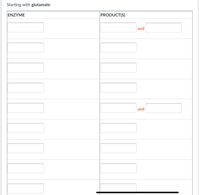
Biochemistry
9th Edition
ISBN: 9781319114671
Author: Lubert Stryer, Jeremy M. Berg, John L. Tymoczko, Gregory J. Gatto Jr.
Publisher: W. H. Freeman
expand_more
expand_more
format_list_bulleted
Question
thumb_up100%
There are eighteen (18) rows of boxes, for around 36-38 boxes total. Please see images attached. This is a pathway trace, with the final box showing "ribose 5 phosphate" as the end product.
Any help is appreciated-thank you!
- glutamate to ribose 5 phosphate
- No a ketoglutarate dehydrogenase
- No pyruvate carboxylase
- No transketolase
- No transaminase
- You do get to have if needed:
- erythrose 4 phosphate
- asparate
- dihydroxyacetone phosphate
- bicarbonate
- ATP
- ornithine
- CO2

Transcribed Image Text:The image is a table meant for educational purposes, focusing on biochemical processes starting with glutamate. It is structured into two main columns:
1. **ENZYME**: This column is where the names of enzymes involved in the metabolic pathways starting from glutamate will be listed. It contains multiple blank cells for input.
2. **PRODUCT(S)**: This column is designated for the products formed from the action of the corresponding enzymes listed in the first column. Each row has two blank fields for potentially listing multiple products, separated by the word "and."
The table is organized to explore and understand the enzymatic conversions and resulting products starting with the amino acid glutamate.

Transcribed Image Text:The image displays a table with ten empty fields, presumably intended for input of specific information related to biochemical processes or molecules. Below these fields, the text "ribose 5 phosphate" is visible. This term refers to a crucial component in the pentose phosphate pathway, which is vital for cellular metabolic processes including nucleotide synthesis.
There are no graphs or diagrams in this image to describe further.
Expert Solution
This question has been solved!
Explore an expertly crafted, step-by-step solution for a thorough understanding of key concepts.
This is a popular solution
Trending nowThis is a popular solution!
Step by stepSolved in 3 steps with 2 images

Knowledge Booster
Similar questions
- please help me in answering all even without explanation, thank you so much... please pleasearrow_forwardSelect the BEST answer. Increasing the concentration of Fructose-2,6 bisphosphate would Inhibit Phosphofructokinase 2 Increase the concentration of Fructose-1,6 bisphosphate (phosphofructose isomerase) O increase the synthesis of glycogen Increase the carboxylation of Ac-CoA to make more malonyl-CoA increase the concentration of Pyruvatearrow_forwardI don't get it at all. I struggled with my homework. Can you help me? Can you help me to explain to me to get the ANSWER: 107 ATP, please?arrow_forward
- Part A Using abbreviations (not structures), write the reaction of coenzyme A that gives off energy (-AG). Match the items in the left column to the appropriate blanks in the equation on the right. CoA+ acetate acetyl acetyl CoA. COA acetyl Previous Answers Request Answer Submit Reset Helparrow_forwardBelow is an image showing how cellular respiration is regulated. Imagine someone ingested a toxin that prevents pyruvate from entering the mitochondria. Which of the following statements is true? Inhibits ATP Glucose GLYCOLYSIS Copyright 2018 Pearson Canada Inc. Fructose 6-phosphate Phosphofructokinase Fructose 1,6-bisphosphate Pyruvate Acetyl COA CITRIC ACID CYCLE Oxidative phosphorylation AMP I Stimulates Inhibits Citrate The amount of citrate in the cell would decrease, leading to a decrease in the activity of phosphofructokinse. The amount of citrate in the cell would increase, leading to a decrease in the activity of phosphofructokinse. The amount of citrate in the cell would decrease, leading to an increase in the activity of phosphofructokinse. The amount of citrate in the cell would increase, leading to an increase in the activity of phosphofructokinse.arrow_forwardKindly please answer it fast.arrow_forward
- + edu.au/courses/26618/quizzes/67364/take The image below shows the urea cycle. Based on the information in the image, which of the following is the most effective way of reducing the production of urea? CNH, Fumarate Arginine H₂O Arginase NH3+ C=N Arginino- succinate AMP + PP₁ NH₂ Arginino- succinase UREA CYCLE Urea ATP Argininosuccinate synthetase Ornithine H₂N H₂N 2 Citrulline Rate- limiting Ornithine 1. Carbamoyl phosphate synthase 1 N-acetyl glutamate H+ADP P₁ NH3 HCO3 ATP Carbamoyl Phosph. NH₂C-PO4 Ornithine 2. Citrulline formation P Citrulline C-NH₂ transcarbamoylase Aspartate NH₂ CYTOSOL MITOCHONDRIAL MATRIX https://canvas.uts.edu.au/assessment questions/356957/files/1562677/download? verifier=gRMPoy7VCgDrvn6QNfkZxDSsbLUwP1gRxFB3dLPjarrow_forwardCarbamoyl phosphate synthetase I is located in liver mitochondria. TRUE/ FALSEarrow_forward
arrow_back_ios
arrow_forward_ios
Recommended textbooks for you
 BiochemistryBiochemistryISBN:9781319114671Author:Lubert Stryer, Jeremy M. Berg, John L. Tymoczko, Gregory J. Gatto Jr.Publisher:W. H. Freeman
BiochemistryBiochemistryISBN:9781319114671Author:Lubert Stryer, Jeremy M. Berg, John L. Tymoczko, Gregory J. Gatto Jr.Publisher:W. H. Freeman Lehninger Principles of BiochemistryBiochemistryISBN:9781464126116Author:David L. Nelson, Michael M. CoxPublisher:W. H. Freeman
Lehninger Principles of BiochemistryBiochemistryISBN:9781464126116Author:David L. Nelson, Michael M. CoxPublisher:W. H. Freeman Fundamentals of Biochemistry: Life at the Molecul...BiochemistryISBN:9781118918401Author:Donald Voet, Judith G. Voet, Charlotte W. PrattPublisher:WILEY
Fundamentals of Biochemistry: Life at the Molecul...BiochemistryISBN:9781118918401Author:Donald Voet, Judith G. Voet, Charlotte W. PrattPublisher:WILEY BiochemistryBiochemistryISBN:9781305961135Author:Mary K. Campbell, Shawn O. Farrell, Owen M. McDougalPublisher:Cengage Learning
BiochemistryBiochemistryISBN:9781305961135Author:Mary K. Campbell, Shawn O. Farrell, Owen M. McDougalPublisher:Cengage Learning BiochemistryBiochemistryISBN:9781305577206Author:Reginald H. Garrett, Charles M. GrishamPublisher:Cengage Learning
BiochemistryBiochemistryISBN:9781305577206Author:Reginald H. Garrett, Charles M. GrishamPublisher:Cengage Learning Fundamentals of General, Organic, and Biological ...BiochemistryISBN:9780134015187Author:John E. McMurry, David S. Ballantine, Carl A. Hoeger, Virginia E. PetersonPublisher:PEARSON
Fundamentals of General, Organic, and Biological ...BiochemistryISBN:9780134015187Author:John E. McMurry, David S. Ballantine, Carl A. Hoeger, Virginia E. PetersonPublisher:PEARSON

Biochemistry
Biochemistry
ISBN:9781319114671
Author:Lubert Stryer, Jeremy M. Berg, John L. Tymoczko, Gregory J. Gatto Jr.
Publisher:W. H. Freeman

Lehninger Principles of Biochemistry
Biochemistry
ISBN:9781464126116
Author:David L. Nelson, Michael M. Cox
Publisher:W. H. Freeman

Fundamentals of Biochemistry: Life at the Molecul...
Biochemistry
ISBN:9781118918401
Author:Donald Voet, Judith G. Voet, Charlotte W. Pratt
Publisher:WILEY

Biochemistry
Biochemistry
ISBN:9781305961135
Author:Mary K. Campbell, Shawn O. Farrell, Owen M. McDougal
Publisher:Cengage Learning

Biochemistry
Biochemistry
ISBN:9781305577206
Author:Reginald H. Garrett, Charles M. Grisham
Publisher:Cengage Learning

Fundamentals of General, Organic, and Biological ...
Biochemistry
ISBN:9780134015187
Author:John E. McMurry, David S. Ballantine, Carl A. Hoeger, Virginia E. Peterson
Publisher:PEARSON